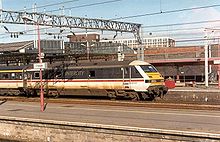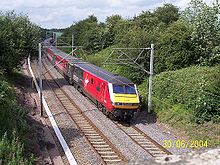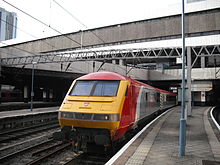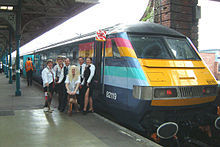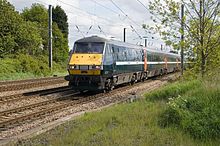- Driving Van Trailer
-
This article is about British DVTs, which are a type of railway control car.
British Rail DVT 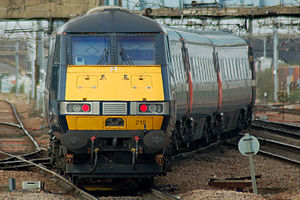
An East Coast Mark 4 DVT at Peterborough station.In service 1988 – present Manufacturer BREL, Metro-Cammell Family name British Rail Mk3 (82101–82152)
British Rail Mk4 (82200–82231)
British Rail Mk3 (82301–82305)
RefurbishedConstructed 1988 Number built Mk3: 52
Mk4: 32Number scrapped Mk3: 1
Mk4: 1Fleet numbers 82101–82152
82301-82305
82200–82231Operator Chiltern Railways
DB Schenker
National Express East Anglia
East Coast
Virgin TrainsSpecifications Car length 18.83 m (61 ft 9 in) Width 2.71 m (8 ft 11 in) Height 3.88 m (12 ft 9 in) Maximum speed Mk3: 110 mph (177 km/h)
Mk4: 140 mph (225 km/h)Weight 43.7 tonnes (96,000 lb) Braking system(s) Air Gauge 1,435 mm (4 ft 8 1⁄2 in) A Driving Van Trailer (DVT) is a purpose-built railway vehicle that allows the driver to operate a locomotive at the opposite end of a train. Trains operating with a DVT therefore do not require the locomotive to be moved around to the other end of the train at terminal stations. Unlike many other control cars, DVTs resemble locomotives (specifically Class 91) and thus when the train is operating in "push" mode it does not appear to be travelling backwards. The vehicles have no passenger accommodation due to rules in place at the time of building that prohibited passengers in the leading vehicles of trains that travel at more than 100 miles per hour (160 km/h).
Contents
Development
On the InterCity 225 (IC225) sets operating on the East Coast Main Line (ECML) the Mark 4 DVTs and locomotives operate in push-pull formation utilising a Time-Division Multiplexer to send control signals along specially screened cables which run the length of the train. The locomotives usually face away from London, only being changed occasionally in rare circumstances.
On the original Mark 3 DVTs, which operated on the West Coast Main Line (WCML), the intention was to use the RCH jumpers to carry the signals therefore allowing the same cables to be used for lighting and the public address system, as well as driver-guard signalling. However this proved to be very troublesome in service and eventually the rakes of coaches on the WCML were re-wired with specially screened cables exclusively for the TDM system.
In addition to the driver's cab, some DVTs have luggage and cycle storage space and a guard's office.
When a train is operated by a DVT, the control signals are encoded and multiplexed onto the cables by the TDM equipment in the DVT. At the locomotive, these signals are demultiplexed by the TDM equipment, and the signals are used to control the locomotive. The air braking system is operated directly from whichever cab the driver is driving from. If the TDM fails and cannot be reconfigured, the train may still operate, but if the DVT is leading, it will be necessary to uncouple the locomotive and attach it to the front of the train.
The DVT was developed from the Mark 2 DBSO, but unlike its predecessor, it was built specifically for this purpose. The original DVTs were designed to be used with Mark 2 D, E & F and Mark 3 coaches, and the second design with Mark 4 coaches, which have a narrower profile. This enables it to be converted to tilting operation if required in the future.
Mark 3 DVTs can be seen in service in the UK today with EWS, with National Express East Anglia Mainline services and occasionally with Virgin West Coast, powered by Class 90 locomotives. During its operation, Wrexham & Shropshire utilised Mark 3 DVTs on its services between London and Wrexham powered by Class 67 locomotives. The Mark 4 DVT is operated by East Coast and powered by Class 91s. They were also powered by the unique Class 89 Co-Co locomotive which once operated on the same route but is now preserved.
Mark 3 DVT
Operators
Virgin West Coast
Virgin West Coast used to operate push-pull services on WCML between London Euston, Liverpool Lime Street, Manchester, Birmingham and Glasgow in conjunction with Class 86, Class 87 and Class 90 locomotives, but latterly the services went on to be run exclusively by Class 390 Pendolinos. Virgin retained two DVTs for backup purposes, both DVTs have recently[year needed] been fitted with on-train monitoring recorders (OTMR). As of July 2009[update], one of the vehicles had been repainted into a Pendolino silver/black livery, in order to bring it in line with the newer trains.
National Express East Anglia
National Express East Anglia operate push-pull services between London London Liverpool Street and Norwich in conjunction with Class 90 locomotives. These DVTs were originally used by Virgin West Coast until the Pendolinos were fully operational. All the WCML DVTs needed refurbishing when they came off lease and were re-painted into 'one' colours.
DB Schenker
DB Schenker (Formerly known as EWS) operate a Mark 3 DVT as part of their EWS Company Train. 82146 is painted in the Silver colours of the company train and operates with Class 67 67029 and three Mark 3 coaches.
Chiltern Railways
Wrexham & Shropshire started operating push-pull services with DVTs in October 2008 between Wrexham General and London Marylebone in conjunction with Class 67 diesel locomotives following the start of the service on 28 April 2008. The DVTs required modification to work with the Class 67, involving adding a notched power controller as is used in the locomotive and a 27 wire jumper cable as used on the GM EMD locomotives which is known as the AAR Multiple Working system. These DVTs were originally used by Virgin West Coast until the Pendolinos were fully operational.
Although these services did start operation in April 2008, no DVTs were initially used due to delays in the refurbishment of the units. Up to mid October WSMR trains used two Class 67 Locomotives - one at either end of the train. On 11 October 2008 the first DVT entered traffic on a WSMR service.
Following the closure of Wrexham & Shropshire these vehicles transferred to sister company Chiltern Railways and started operating on Birmingham to London Marylebone services. They are currently being further modified to work with the power doors that Chiltern are fitting to the Mk3 coaches and to have a generator fitted to enable Electric Train Supply and compressed air to be provided to the coaches when the Class 67 locomitve is not running, such as when in terminus stations and when stabled.
As a result of the modification to work with the Class 67s, the WSMR DVTs have been renumbered 82/3 series although they do retain the ability to work with TDM fitted electric locomotives.
Current Status
Key: In Service Stored Scrapped Renumbered Other Use Number Name(s) Built Final Livery Operator Status 82101 Wembley InterCity Depot
101 Squadron1988 Derby Virgin Red/Black Porterbrook Stored 82102 - 1988 Derby ’one’ slate grey with NXEA white stripe National Express East Anglia In service 82103 - 1988 Derby ’one’ slate grey with NXEA white stripe National Express East Anglia In service 82104 - 1988 Derby Virgin Red/Black National Express East Anglia Training vehicle for drivers at Norwich Crown Point 82105 - 1988 Derby ’one’ slate grey with NXEA white stripe National Express East Anglia In service 82106 - 1988 Derby Virgin Red/Black Porterbrook Stored 82107 - 1988 Derby National Express East Anglia Silver National Express East Anglia In service 82108 - 1988 Derby Virgin Red/Black Porterbrook Stored 82109 - 1988 Derby Virgin Red/Black Porterbrook Stored 82110 - 1988 Derby Virgin Red/Black Porterbrook Stored 82111 - 1988 Derby Virgin Red/Black Porterbrook Stored 82112 - 1988 Derby ’one’ slate grey with NXEA white stripe National Express East Anglia In service 82113 - 1988 Derby Virgin Red/Black Porterbrook Stored 82114 - 1988 Derby ’one’ slate grey with NXEA white stripe National Express East Anglia In service 82115 - 1988 Derby BR Blue DB Schenker In service 82116 - 1988 Derby Virgin Red/Black Porterbrook Stored 82117 - 1988 Derby Renumbered 82301 82118 Britannia 1988 Derby ’one’ slate grey with NXEA white stripe National Express East Anglia In service 82119 - 1988 Derby Scrapped at MoD Caerwent (11/2005) 82120 Liverpool Chamber of Commerce 1988 Derby Virgin Red/Black Porterbrook Stored 82121 Carlisle Cathedral 1988 Derby ’one’ slate grey with NXEA white stripe National Express East Anglia In service 82122 - 1988 Derby Virgin Red/Black Porterbrook Stored 82123 - 1988 Derby Virgin Red/Black Porterbrook Stored 82124 The Girls' Brigade 1988 Derby Virgin Red/Black Porterbrook Stored 82125 - 1988 Derby Virgin Red/Black Porterbrook Stored 82126 G8 Summit Birmingham 1998
Wembley Traincare Depot1988 Derby Virgin "Pendolino" Silver/Red Virgin Trains In service 82127 Abraham Darby 1988 Derby ’one’ slate grey with NXEA white stripe National Express East Anglia In service 82128 - 1988 Derby Virgin Red/Black Porterbrook Stored 82129 - 1988 Derby Virgin Red/Black Porterbrook Stored 82130 - 1988 Derby Renumbered 82304 82131 - 1988 Derby Virgin Red/Black Porterbrook Stored 82132 West Midlands Industry '96 1988 Derby ’one’ slate grey with NXEA white stripe National Express East Anglia In service 82133 - 1988 Derby ’one’ slate grey with NXEA white stripe National Express East Anglia In service 82134 - 1988 Derby Renumbered 82305 82135 Spirit of Cumbria 1988 Derby Renumbered 82303 82136 - 1988 Derby ’one’ slate grey with NXEA white stripe National Express East Anglia In service 82137 - 1988 Derby Virgin Red/Black Porterbrook Stored 82138 - 1988 Derby Virgin Red/Black Porterbrook Stored 82139 - 1988 Derby ’one’ slate grey with NXEA white stripe National Express East Anglia In service 82140 - 1988 Derby Virgin Red/Black Porterbrook Stored 82141 - 1988 Derby Virgin Red/Black Porterbrook Stored 82142 - 1988 Derby Virgin Red/Black Porterbrook Stored 82143 - 1988 Derby ’one’ slate grey with NXEA white stripe National Express East Anglia In service 82144 - 1988 Derby Virgin Red/Black Porterbrook Stored 82145 - 1988 Derby Virgin Red/Black Porterbrook Stored 82146 - 1988 Derby EWS Silver DB Schenker In service 82147 The Red Devils 1988 Derby Virgin Red/Black Porterbrook Stored 82148 International Spring Fair 1988 Derby Virgin Red/Black Porterbrook Stored 82149 101 Squadron 1988 Derby Virgin Red/Black Fire Service College, Moreton-in-Marsh Training vehicle for fire-fighters at Fire Service College, Moreton-in-Marsh 82150 - 1988 Derby Virgin Red/Black Porterbrook Stored 82151 - 1988 Derby Renumbered 82302 82152 - 1988 Derby ’one’ slate grey with NXEA white stripe National Express East Anglia In service 82301 - 1988 Derby Wrexham & Shropshire Silver/Grey Chiltern Railways In service - Renumbered from 82117 82302 - 1988 Derby Chiltern Railways White/Blue Chiltern Railways In service - Renumbered from 82151 82303 - 1988 Derby Wrexham & Shropshire Silver/Grey Chiltern Railways In service - Renumbered from 82135 82304 - 1988 Derby Wrexham & Shropshire Silver/Grey Chiltern Railways In service - Renumbered from 82130 82305 - 1988 Derby Wrexham & Shropshire Silver/Grey Chiltern Railways In service - Renumbered from 82134 Mark 4 DVT
Mark 4 DVTs were built in 1988 by Metro Cammell at their Washwood Heath plant in Birmingham and were introduced to the ECML with the IC225 rakes of Mark 4 coaches. They operate with class 91 locomotives using the TDM system via UIC screened cables through the nine Mark 4 coaches of the rake.Initially operated by British Rail's InterCity sector in its familiar livery, following privatisation of the railways the services were taken over by Sea Containers under the Great North Eastern Railway (GNER) brand but following a change of operator to National Express East Coast in December 2007 the vehicles were rebranded with NXEC logos and a white stripe whilst retaining the overall GNER blue colour scheme . However, the collapse of the NXEC franchise in November 2009 and its replacement by the Government operated East Coast operator means that the current mix of liveries will probably remain until a new private franchisee is found in 2011.
Key: In Service Scrapped Number Name Built Livery Operator Status 82200 - 1988 Metro-Cammell GNER Blue with East Coast White Stripe East Coast In service (Note: was involved in Hatfield rail crash) 82201 - 1988 Metro-Cammell GNER Blue with East Coast White Stripe East Coast In service 82202 - 1988 Metro-Cammell East Coast Silver East Coast In service 82203 - 1988 Metro-Cammell GNER Blue with East Coast White Stripe East Coast In service 82204 - 1988 Metro-Cammell East Coast Silver East Coast In service 82205 Flying Scotsman 1988 Metro-Cammell East Coast Flying Scotsman Purple East Coast In service 82206 - 1988 Metro-Cammell GNER Blue with East Coast White Stripe East Coast In service 82207 - 1988 Metro-Cammell East Coast Silver East Coast In service 82208 - 1988 Metro-Cammell East Coast Silver East Coast In service 82209 - 1988 Metro-Cammell East Coast Silver East Coast In service 82210 - 1988 Metro-Cammell East Coast Silver East Coast In service 82211 - 1988 Metro-Cammell GNER Blue with East Coast White Stripe East Coast In service 82212 - 1988 Metro-Cammell GNER Blue with East Coast White Stripe East Coast In service 82213 - 1988 Metro-Cammell GNER Blue with East Coast White Stripe East Coast In service 82214 - 1988 Metro-Cammell GNER Blue with East Coast White Stripe East Coast In service 82215 - 1988 Metro-Cammell East Coast Silver East Coast In service 82216 - 1988 Metro-Cammell GNER Blue with East Coast White Stripe East Coast In service 82217 Off to the Races 1988 Metro-Cammell GNER Blue with East Coast White Stripe East Coast In service 82218 International Indian Film Academy Awards 1988 Metro-Cammell GNER Blue with East Coast White Stripe East Coast In service 82219 Duke of Edinburgh 1988 Metro-Cammell East Coast Silver East Coast In service 82220 - 1988 Metro-Cammell GNER Blue with East Coast White Stripe East Coast In service 82221 - 1988 Metro-Cammell Scrapped after the Great Heck rail crash on February 28, 2001. 82222 - 1988 Metro-Cammell GNER Blue with East Coast White Stripe East Coast In service 82223 - 1988 Metro-Cammell GNER Blue with East Coast White Stripe East Coast In service 82224 Passionate People, Passionate Places 1988 Metro-Cammell GNER Blue with East Coast White Stripe East Coast In service 82225 - 1988 Metro-Cammell GNER Blue with East Coast White Stripe East Coast In service 82226 - 1988 Metro-Cammell GNER Blue with East Coast White Stripe East Coast In service 82227 - 1988 Metro-Cammell GNER Blue with East Coast White Stripe East Coast In service 82228 - 1988 Metro-Cammell GNER Blue with East Coast White Stripe East Coast In service 82229 - 1988 Metro-Cammell GNER Blue with East Coast White Stripe East Coast In service 82230 - 1988 Metro-Cammell GNER Blue with East Coast White Stripe East Coast In service 82231 - 1988 Metro-Cammell GNER Blue with East Coast White Stripe East Coast In service Mark 5 DVT
Main article: British Rail Mark 5The Mark 5 DVT was to be part of British Rail's ill-fated InterCity 250 project on the West Coast Mainline.
Accidents and incidents
DVTs have been involved in very few accidents.
- Hatfield derailment involving DVT 82200
- Great Heck rail crash, February 2001. 82221 was withdrawn after major damage to the DVT
See also
Coaching stock of British Rail Passenger coaches Mark 2:BFO · CO · FO · RFM · SLE · SLED · SLEP · TSO · TSOB - (Locomotive hauled)
TF · TGS · TRB · TRFB · TRFK · TRSB · TS - (InterCity 125 trailers)Other Mark 1:DVT
Categories:- British Rail coaching stock
- BREL products
Wikimedia Foundation. 2010.

